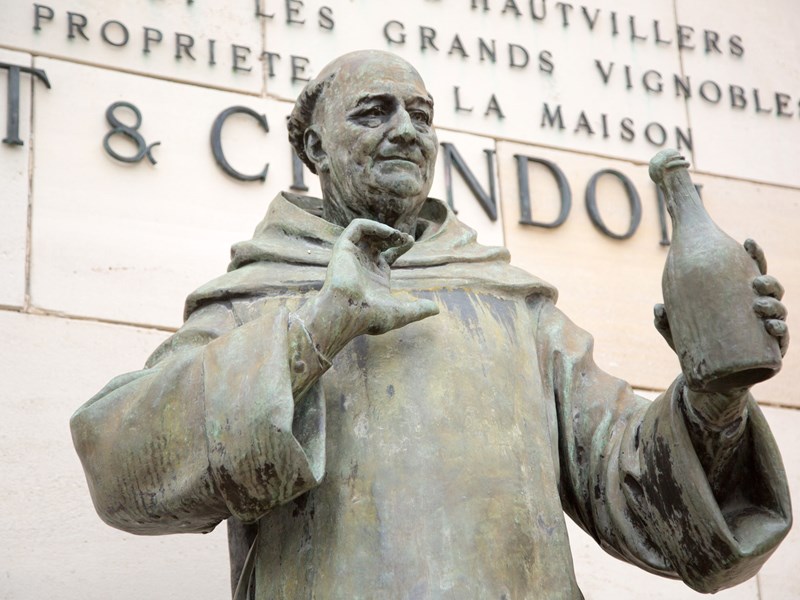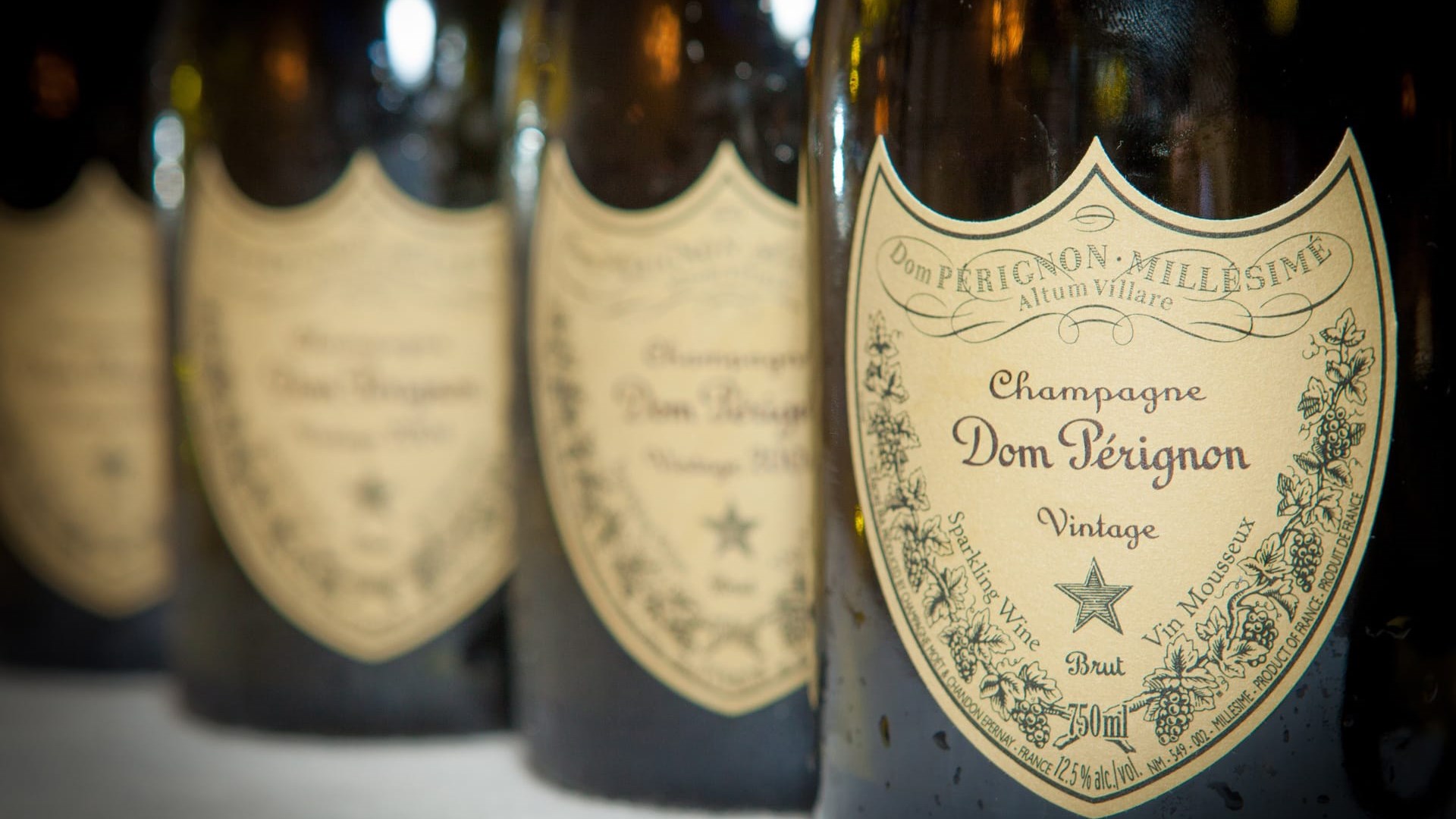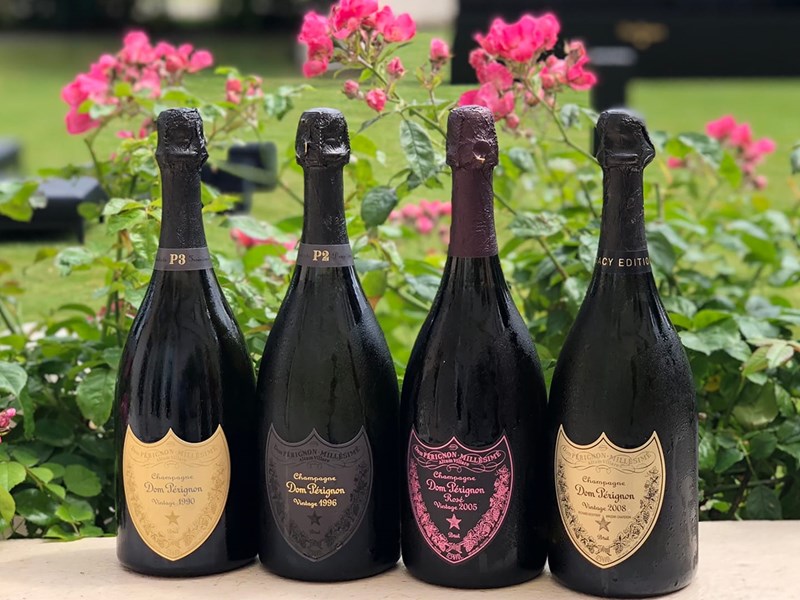Article - RareWine Academy
Dom Perignon - The Monk, The Legend & The Wine
No, the monk Dom Pérignon did not invent Champagne, nor sparkling wine. But he is definitely a legend in Champagne - probably the greatest of them all!
Dom Pérignon! The name itself inspires a certain kind of reverence. Dom Pérignon is today much more than just a brand, and more than just another Champagne. Dom Pérignon is a luxury icon - a symbol of extravagance and wealth - known and respected not only by wine lovers but indeed by young and old from all corners of the globe.
Dom Pérignon is owned by the world's largest luxury conglomerate LVMH Group, which is also behind Louis Vuitton, Moët & Chandon, Hennessy, Ruinart, and Krug just to name a few.
 The monk and the legend Dom Pierre Pérignon
The monk and the legend Dom Pierre Pérignon
Who Was The Monk Dom Pierre Pérignon?
The tales and myths about Dom Pierre Pérignon are many, but far from all are true. Pierre Pérignon was born in 1638 in the Champagne region of northern France. At the age of 19, he chose to enter a monastery and become a Benedictine monk. This led him to the monastery of Hautvillieres, where he arrived in 1668. At the time, the monks were among the largest landowners and, not least, producers of the wine of the time. Dom Pierre Pérignon was a cellar master at Hautvillieres until he died in 1715 and became particularly famous for his many experiments both in the vineyard and in the cellar. Experiments, that have greatly contributed to and influenced the production of sparkling wines in the years since.
As far back as 1662, the production of sparkling wine is documented for the first time, in England of all places. Christopher Merret introduced the idea that all wines could be made sparkling if just the right amount of sugar and yeast were added before bottling. This creates a new fermentation in the bottle, which creates bubbles. With strong glass bottles and wine imported in oak barrels from France, the stage was set for making sparkling wine on a larger scale in England.
Even further back in history, however, there have also been wines with bubbles. Wines where it has been difficult to control the production, allowing fermentation to continue and thus integrating bubbles into the wine. Both back in Greek and Roman history, variations of sparkling wines have been mentioned. So, to credit Dom Pierre Pérignon for inventing sparkling wine or Champagne is not correct, but his experiments have helped shape production in the aftermath.
Dom Pierre Pérignon And His Influence On The Wine
Dom Pierre Pérignon gave the wine much attention in both the vineyard and the cellar in a whole new way. In the vineyard, he explored the different grapes and the concept of 'terroir'. Each vineyard, with its terroir, gave a distinctive character to the final wine. He succeeded in putting this kind of desirable complexity into practice.
That the choice of grapes is not a matter of chance can also be partly attributed to Dom Pierre Pérignon. In his time, northern France was very cold, and the Chardonnay grapes had challenges with ripening. Dom Pierre Pérignon chose to work with Pinot Noir on a larger scale, which was much better suited to both the climate of the time and the climate of this part of France today. At the same time, he was able to make pure white wine from the blue Pinot Noir grape by pressing directly after harvest.
In some places, Dom Pierre Pérignon is also credited with being the first to use cork stoppers to seal bottles. However, this was done earlier, but the combination of the strong bottles from England and thicker corks can be attributed to Dom Pierre Pérignon.
Another thing that Dom Pierre Pérignon controlled was the blending of the wine itself. Even at harvest, he thought it was worthwhile to blend the individual grapes to achieve the desired complexity. The vineyards around the monastery had all the classic grapes planted, but the focus was already at this time on the best of them, namely Pinot Noir and Chardonnay. Today's Dom Pérignon Champagne still uses grapes harvested in the monastery's vineyards in Hautvilliers, to honor the origins of the man and the wine.
Dom Pierre Pérignon died in 1715 and is buried in the choir of the monastery of Hautvilliers. On his tombstone is written "summa cum laude" meaning "with highest praise", which he strove for in all phases of his life. This is also the motto of the Benedictine monks.
Dom Pierre Pérignon did many revolutionary things that are still used today to make the best sparkling wines in the world. His legend rightly lives on, both in the Champagne region and around the world.
Read more about the production of champagne here
1921 Is The First Vintage Of Dom Pérignon Champagne
Dom Pérignon can rightly be called the first prestige cuvée in Champagne, which with the 1921 vintage, was the first to come on the market in 1936. At that time, this was the prestige cuvée of Möet & Chandon. The wine was made with second fermentation in a regular bottle, and only when disgorged, it was bottled in the (later classic) thick Dom Pérignon bottle. This was the process up to and including the 1943 vintage.
The first 300 bottles were sold through an English importer and got such good attention that the interest quickly spread across the Atlantic to the United States, where the next order was for 100 cases of Champagne. Of this first shipment, American billionaire James Buchanan Duke ordered 100 bottles for himself, but only drank the 83 bottles. In 2004, the last 17 bottles were auctioned at Christie's in New York. The sale price was $4,000 per bottle. One of the bottles was tasted, and Dom Pérignon cellar master Richard Geoffroy said at the tasting, "Exceptionally pale for its age, the wine showcases an intriguing bouquet of toasted sandalwood, vanilla, honey, praline, and marzipan. On the palate, one is struck by life, energy, and the backbone. It remains focused, with a lacy texture. A key feature is the tremendous persistence of dry nutty flavors. Overall, a model of balance and concentration."
After World War II, the focus changed at Möet & Chandon, and Dom Pérignon became its own wine, where there was full focus on the whole process of this single wine. Möet & Chandon was still on the label until the early 1990s, and Dom Pérignon was the prestige cuvée from that point. Since then, it has been separated as its own brand, and today, there is even more focus on the quality and details of the wine.
 Dom Pérignon and the iconic label.
Dom Pérignon and the iconic label.
Today's Dom Pérignon Champagne
A bit of mystery, a bit of secrecy, and ultimately one of the best bottles of wine in the world. That is the bottom line. By default, Dom Pérignon is always a vintage wine of the highest caliber, a wine that is only released when the cellar master believes the quality is up to it.
Several million bottles are produced in each vintage, we suspect. Probably in the region of five to eight million bottles, distributed worldwide. The bottle includes grapes from several different villages and primarily from Grand Cru villages in the core areas of Champagne. There is also, as mentioned, a small share from the monastery of Hautvilliers, where Dom Pérignon started his work in each bottle.
The wine is combined only of Chardonnay and Pinot Noir, no other grapes, only the best is good enough. In most vintages, there are equal parts of the two grapes in the blend, but it can vary by up to 10%.
The exact dosage is not mentioned, but in recent years, it has probably decreased from the previous 8 grams per liter to about 5 grams per liter. An adaptation to a market where consumers want wines with more precision and less sugar.
Vincent Chaperon - The Conductor Behind The Masterpiece
The combination of the right parcels, the right grapes, and the perfect production naturally require a firm hand. At Dom Pérignon, the cellar master is the conductor, who composes the wine. From 1998 to 2010, it was Richard Geoffroy, who carried out this honorable task, and since then, the baton has been passed on to Vincent Chaperon. Before the handover, the two gentlemen worked together for 13 years, so the legacy is being passed on in the best possible way. The cellar master naturally has a large stable team around him to assist with the whole process. And who knows, maybe the future cellar master is already working in the cellar to learn all the details?
 Various releases of Dom Perignon
Various releases of Dom Perignon
The Different Dom Pérignon Wines
Dom Pérignon is just one wine and yet not. Various other versions have been developed over the years, still under the name Dom Pérignon. Late disgorged versions, labels designed by famous people, and a great version in rosé.
Dom Pérignon Millesimé
This is the well-known and famous version that the whole world has come to know. It is produced in the best-selected vintages and is synonymous with Dom Pérignon. With the latest release - the 2012 vintage - a total of 45 vintages have been produced, which together form the core of the entire Dom Pérignon range.
It is made from equal parts Pinot Noir and Chardonnay from the best villages in Champagne. It always includes small quantities of grapes from the vineyard of the monastery of Hautvillers, where Dom Pérignon was cellar master. This wine is Plenitude 1 and is released after 8 - 10 years depending on the vintage. This is the wine that everyone knows and that the whole world wants to taste. It is ready to drink when it is released to the market but only becomes more complex and balanced with time.
Dom Pérignon Millesimé has been produced in the following vintages: 1921, 1926, 1928, 1929, 1934, 1943, 1947, 1949, 1952, 1953, 1955, 1959, 1961, 1962, 1964, 1966, 1969, 1970, 1971, 1973, 1975, 1976, 1978, 1980, 1982, 1983, 1985, 1988, 1990, 1992, 1993, 1995, 1996, 1998, 1999, 2000, 2002, 2003, 2004, 2005, 2006, 2008, 2009, 2010 og 2012.
Dom Pérignon Plénitude 2 (P2) & Dom Pérignon Plénitude 3 (P3)
These are both late disgorged versions of Dom Pérignon. Especially selected vintages that have been in the cellar for a long time to develop more complexity and finesse. Plénitude means "fullness" but can be interpreted as the full authority. So here Dom Pérignon gives the authority to you as a wine lover to taste the perfect development of the wine.
Plénitude 2 is released after 15-18 years, where it has retained its freshness with additional complexity from the extended aging. Plénitude 3 is the epitome of what Dom Pérignon can become after more than 25 years in the cellar. This is the ultimate Dom Pérignon, showing all the facets that can be achieved in this wine.
In the perfect world, you can taste the same wine in three different versions and have the ultimate horizontal wine tasting. Earlier versions of these were named 'Oenotheque', but since the release of P2 in 1998, Dom Pérignon has used 'Plénitude' as its designation.
Dom Pérignon Rosé
A small unknown amount of Dom Pérignon is produced in rosé. The grape composition is slightly higher on Pinot Noir, which contributes to the red color. Rosé is not produced in as many vintages as Millesimé.
The first vintage of rosé Dom Pérignon was 1959, made at the request of the Shah of Iran to celebrate the 2,500th anniversary of the Persian Empire in 1971. And so, another legend was born from the iconic 1959 vintage.
The following 26 vintages have been produced as Dom Pérignon Rosé: 1959, 1962, 1964, 1966, 1969, 1971, 1973, 1975, 1978, 1980, 1982, 1985, 1986, 1988, 1990, 1992, 1993, 1995, 1996, 1998, 2000, 2002, 2003, 2004, 2005 and 2006.
Dom Pérignon Special Editions
In addition, several special editions are produced featuring well-known actors, musicians, and other celebrities. There are versions with lights (Luminous), which are extremely popular in nightclubs, and special labels in design collaboration with, for example, Lenny Kravitz. Most of the other versions are also bottled in larger formats, from magnum and even larger formats too. The bigger the bottle, the better the aging potential.
Investment Potential And The Future Of Dom Perignon
Despite large production, Dom Pérignon is still a very good investment - both taste-wise and financially. Champagne is characterized by enormous consumption and minimal speculation. Untold quantities of Champagne are consumed daily all over the world. Large quantities are even drunk in the years immediately after release when the novelty value is greatest, but an even greater organoleptic experience awaits those who have the patience to wait.
When a bottle of Dom Pérignon is 20 to 30 years old, from the harvest year, it begins to show a whole new complexity, with the aging in the bottle giving it extra depth. If you have even more patience, another 20 years in the bottle adds another new experience.
The price also influences consumption, which means that many people can afford to drink it. It is not unattainable to get close to a bottle of Dom Pérignon, and this has a huge impact on consumption. This also means that it is actually possible to acquire reasonable quantities suitable for investment.
In addition, all indicators point to the fact that Champagne prices are going to increase at a higher rate in the next 10 years than what we have seen in the previous 25 years. This is mainly because the prices of agricultural land in Champagne have increased significantly more than the prices of Champagne in the past years.
Furthermore, production costs have also increased year by year, and add to this the major transformation that the area is undergoing these years towards sustainable production. This leads to higher costs and lower yields. All this is sweet music from an investor's point of view and makes Champagne an extremely attractive investment.
Specifically for Dom Pérignon, it should also not be forgotten that both production and marketing are placed in highly compatible hands with the mighty LVMH group. The quality is possibly better now than ever before, and there is nothing to suggest that it cannot continue in this direction.
Worldwide demand for the best bottles of Champagne is increasing these years, so overall sales of Dom Pérignon are also assured into the future. The large and lucrative Chinese market is also starting to develop a taste for the best Champagnes, so all the indications are that now is the time to act, before the price of Champagne really starts to increase.
